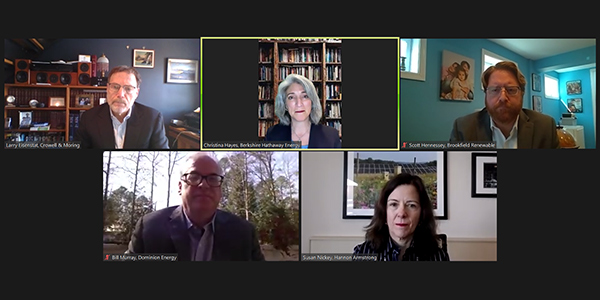A panel of industry stakeholders concluded the American Council on Renewable Energy’s 2021 Policy Forum with a discussion on infrastructure and the policies that might shape the future grid.
ACORE COO Bill Parsons introduced the panel, noting that the discussion couldn’t have come at a better time with the recent passage of the America Rescue Plan.
“America’s infrastructure is critically in need of updating,” Parsons said.
Moderator Larry Eisenstat, partner at Crowell & Moring, said that the purpose of any federal infrastructure plan should be to repower the economy and achieve clean energy targets.
Vice President of Berkshire Hathaway Energy Christina Hayes started off the conversation by saying the biggest inhibitor of infrastructure projects and the adoption of new technologies is often the associated costs. Mitigating “sticker shock” with tax incentives will be key, she said.
Scott Hennessey, vice president of federal policy at Brookfield Renewable, agreed that tax credits will be vital to building out new generation, but he also emphasized the importance of preserving and investing in existing non-emitting resources, specifically hydropower. With a focus on wind and solar generation to meet future energy needs, Hennessey feels that hydropower isn’t being valued as a renewable resource like its counterparts.

Christina Hayes, Berkshire Hathaway Energy | ACORE
“If we are always focused on new generation … we take two steps forward only to take a step back,” he said.
Eisenstat noted that critics of federal clean energy tax credits have said that the renewables industry has matured to a point where incentives are no longer necessary and that new generation buildout would continue with or without them. Hennessey disagreed.
“If what we want is more generation capacity [and] to preserve the good generation capacity we have, that takes investment, and right now, to say, ‘Go off and hit these lofty goals by the administration without the policy support’ seems very difficult,” he said.
Susan Nickey, executive vice president at Hannon Armstrong, responded that her company would like to see policy that attracts private capital. Reaching a net-zero economy is going to take “trillions” of dollars, she said, and a balance between federal tax incentives and private sector investment is going to be necessary to build out the needed infrastructure.
Dominion Energy’s William Murray agreed that the federal government should play a part in modernizing and expanding the grid.
“Federal government has played a transformative role for more than a century in moving new technology forward, and there’s an opportunity … across infrastructure, certainly, and energy to do that,” Murray said.
Building Storage
Eisenstat asked the panel what could be done at the federal level to start seeing the widespread adoption of storage resources necessary to keep a potentially all-renewables grid reliable.
Murray said that current storage technology is not going to be sufficient to get to net zero. He said he would like to see the federal government invest in research and development to maximize storage resources.
Nickey said that investors feel differently. She said that while they’re comfortable with storage technology and interested in new developments, they’re still skeptical that they’ll see a return on their investment.
Incentivizing storage as a transmission asset may be the key to widespread adoption, Hayes said. “Leveling the playing field through the tax credit play with storage would really be helpful.”



